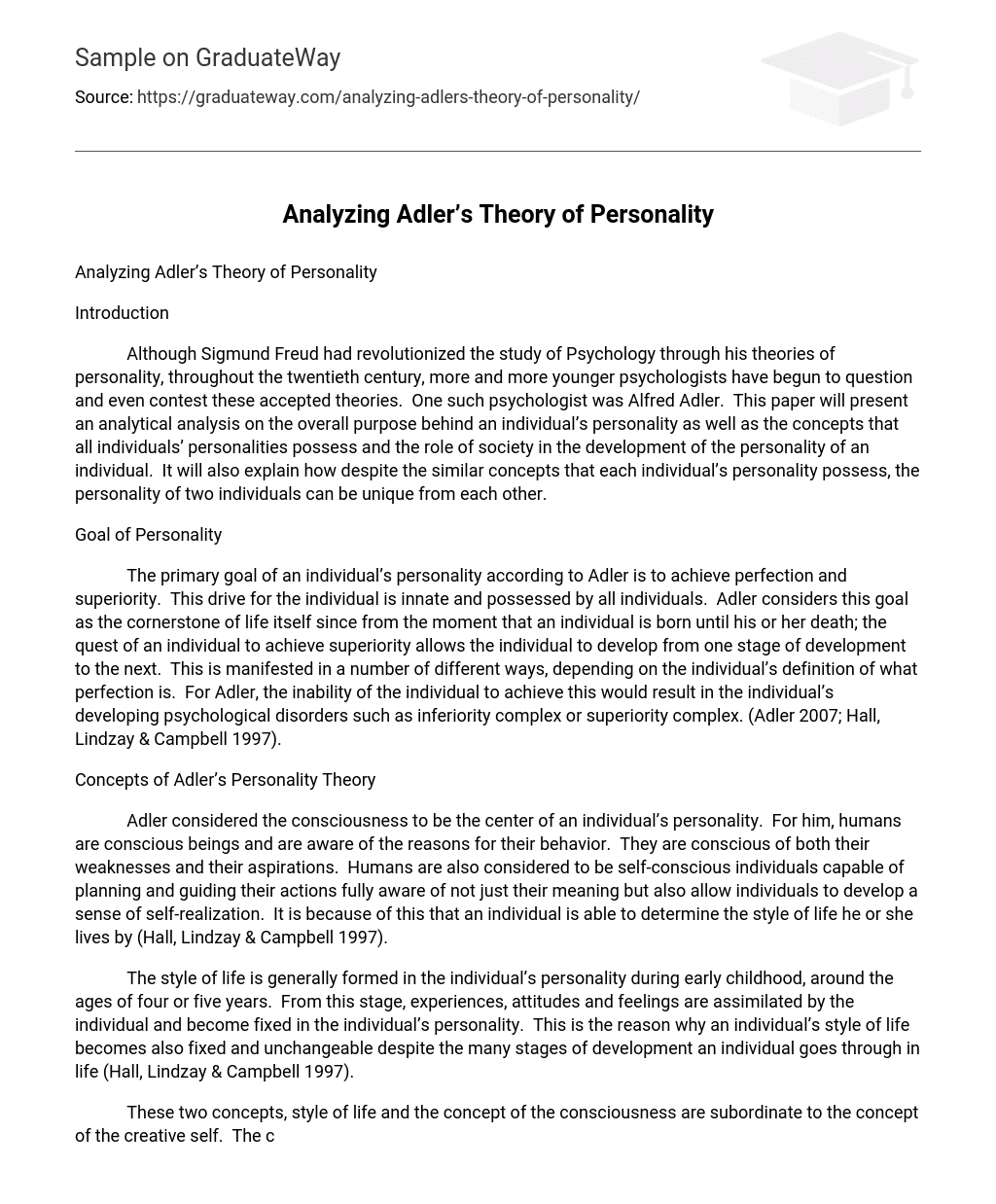Introduction
Although Sigmund Freud had revolutionized the study of Psychology through his theories of personality, throughout the twentieth century, more and more younger psychologists have begun to question and even contest these accepted theories. One such psychologist was Alfred Adler. This paper will present an analytical analysis on the overall purpose behind an individual’s personality as well as the concepts that all individuals’ personalities possess and the role of society in the development of the personality of an individual. It will also explain how despite the similar concepts that each individual’s personality possess, the personality of two individuals can be unique from each other.
Goal of Personality
The primary goal of an individual’s personality according to Adler is to achieve perfection and superiority. This drive for the individual is innate and possessed by all individuals. Adler considers this goal as the cornerstone of life itself since from the moment that an individual is born until his or her death; the quest of an individual to achieve superiority allows the individual to develop from one stage of development to the next. This is manifested in a number of different ways, depending on the individual’s definition of what perfection is. For Adler, the inability of the individual to achieve this would result in the individual’s developing psychological disorders such as inferiority complex or superiority complex. (Adler 2007; Hall, Lindzay & Campbell 1997).
Concepts of Adler’s Personality Theory
Adler considered the consciousness to be the center of an individual’s personality. For him, humans are conscious beings and are aware of the reasons for their behavior. They are conscious of both their weaknesses and their aspirations. Humans are also considered to be self-conscious individuals capable of planning and guiding their actions fully aware of not just their meaning but also allow individuals to develop a sense of self-realization. It is because of this that an individual is able to determine the style of life he or she lives by (Hall, Lindzay & Campbell 1997).
The style of life is generally formed in the individual’s personality during early childhood, around the ages of four or five years. From this stage, experiences, attitudes and feelings are assimilated by the individual and become fixed in the individual’s personality. This is the reason why an individual’s style of life becomes also fixed and unchangeable despite the many stages of development an individual goes through in life (Hall, Lindzay & Campbell 1997).
These two concepts, style of life and the concept of the consciousness are subordinate to the concept of the creative self. The creative self intervenes between the stimuli acting upon the person and the responses made on these stimuli. The creative self is the aspect in the individual’s psyche that gives meaning to life because it is the active principle of life which transforms facts into a personality that is subjective, dynamic, unified, personal and unique (Hall, Lindzay & Campbell 1997).
Role of Society to Adler’s Theory
According to Adler, human by nature are social beings. By this definition, Adler considered the individual to have the innate desire to socialize with other people and his or her environment, making society play an important role in the development of an individual’s personality. Here, Adler believes that the development of an individual’s personality is determined on the guidance and training given by society. This is completely contradictory to Freud’s personality concept which sated that the behavior of the individual is determined by sexual instincts. Society guides and trains an individual through various media such as education and guidance centers. Ideally, society helps the individual to work on the individual’s weaknesses for the benefit of the individual.
Differences in an Individual’s Personality
Because individuals are able to determine the style and personality they have through the concept of style of self, this explains why individuals possess unique personalities. An individual has his or her own definition of what it means to attain superiority resulting to a number of means and ways for the individual to attain this. Because of this, an individual’s behavior is determined and created in such a way that the individual is able to achieve his or her goal. Adler stated that there are four different style of life commonly observed. The first type and the most frequent is the “getting” type. This is characterized with the individual expecting to be given everything. The second type is the “avoiding” type where the individual’s solution for the challenges and problems occurring in life is to avoid them. The third type is the “rulling” type which refers to individuals who do not mingle with others. The last type is the “social useful” type where individuals with this style of life are always in service to others.
Conclusion
Adler’s theory of personality provided two reasons why there are a vast number of differences in personality seen among individuals despite the same situation two individuals are placed in. This theory and concepts showed that man as an individual is not ruled by the notions given by society which is why there are some individuals who exhibit deviant behaviors despite the individual growing up in an environment where others do not exhibit the same behaviors. This could explain why despite having what society may consider as a normal childhood, an individual may become a serial killer. It also provides an explanation why in a crisis some individuals would go the extra mile and why some would run away. More importantly, the permanence of an individual’s style of life would explain as to why despite various treatments and numerous counseling sessions, some behavior exemplified by individuals is considered to be untreatable.
References
Adler, A. (2007). The neurotic constitution: the origin and development of the feeling of
inferiority. In H. S. Friedman & M. W. Schustack (Eds.), The personality reader (pp. 42-43). Needham Heights, MA: Allyn & Bacon.
Hall, C. S., Lindzey, G. & Campbell, J. B. (1997). Theories of personality, 4th ed. New
Jersey: John Wiley & Sons.





